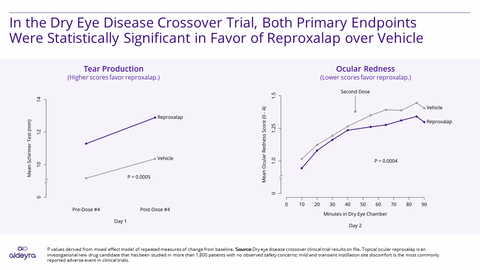- Reproxalap Statistically Superior to Vehicle for Both Primary Endpoints of Ocular Redness (P=0.0004) and Schirmer Test (P=0.0005)
- Schirmer Test ≥10mm Responder Analysis Multiplicity-Controlled Secondary Endpoint Achieved (P=0.0361)
- Secondary Endpoints Achieved for All Symptoms Assessed: Dryness (P=0.0068), Discomfort (P<0.0001), Grittiness (P=0.0001), Stinging (P=0.0001), Burning (P<0.0001), and Itching (P=0.0003)
- Company to Host Conference Call at 8:00 a.m. ET Today
Aldeyra Therapeutics, Inc. (Nasdaq: ALDX) (Aldeyra) today announced the achievement of the primary endpoints in a sequence-randomized, double-masked, vehicle-controlled crossover clinical trial of 0.25% reproxalap ophthalmic solution, an investigational new drug candidate, for the treatment of dry eye disease. Reproxalap was statistically superior to vehicle for each of the two prespecified primary endpoints, ocular redness in a dry eye chamber (P=0.0004) and Schirmer test (P=0.0005), a measure of tear production, after a single day of dosing. The secondary endpoint of Schirmer test ≥10 mm responder analysis, which was multiplicity-controlled, was also achieved (P=0.0361).
This press release features multimedia. View the full release here: https://www.businesswire.com/news/home/20220711005971/en/

Aldeyra Therapeutics, Inc. (Nasdaq: ALDX) on July 12, 2022, announced the achievement of the primary endpoints in a crossover clinical trial of 0.25% reproxalap ophthalmic solution, an investigational new drug candidate, for the treatment of dry eye disease. Reproxalap was statistically superior to vehicle for each of the two prespecified primary endpoints, ocular redness in a dry eye chamber and Schirmer test, a measure of tear production, after a single day of dosing. (Graphic: Aldeyra Therapeutics)
“Statistical significance in favor of reproxalap over vehicle for all three dry eye disease signs that we intend to submit to a New Drug Application, in addition to observed rapid symptomatic improvement, favorably positions reproxalap, if approved for sale, as a potentially differentiated therapeutic option for the treatment of dry eye disease,” stated Todd C. Brady, M.D., Ph.D., President and Chief Executive Officer of Aldeyra.
Relative to vehicle, statistically significant reduction in ocular redness was observed following treatment with reproxalap as soon as 10 minutes after dry eye chamber entry, which was the first time point assessed, and over the majority of chamber assessment time points, including the final time point 90 minutes after chamber entry. Schirmer test, which was assessed approximately 10 minutes before and after the fourth dose of reproxalap or vehicle, was statistically significant in favor of reproxalap at both time points, indicating the potential activity of prior dosing as well as additional activity of the fourth dose over a single day of drug administration. The Schirmer test ≥10 mm responder analysis has been reported to correlate with symptomatic improvement in dry eye disease,1 and achievement of the responder endpoint is consistent with the symptomatic improvement observed in the crossover clinical trial: reproxalap was statistically lower than vehicle for the secondary endpoints of ocular dryness (P=0.0068), discomfort (P<0.0001), grittiness (P=0.0001), stinging (P=0.0001), burning (P<0.0001), and itching (P=0.0003) symptoms.
No safety signals were observed in the trial, and reproxalap was well tolerated; there were no treatment-emergent moderate or serious adverse events. Three patients discontinued due to adverse events, two during vehicle administration and one during reproxalap administration. Reproxalap has now been studied in over 1,800 patients. The most common reported adverse event in clinical trials is mild and transient instillation site discomfort.
Pending discussion with the U.S. Food and Drug Administration (FDA), Aldeyra intends to submit the crossover clinical trial, which was designed to be adequate and well-controlled, as part of a dry eye disease New Drug Application (NDA) for reproxalap, including data on ocular redness, Schirmer test, and the Schirmer test ≥10 mm responder analysis. A pre-NDA meeting with the FDA has been scheduled for the third quarter of 2022. The NDA submission is expected to include a comprehensive set of data from acute and chronic clinical trials, as well as a combination of challenge and field-based assessments and parallel-group and crossover clinical trial designs.
“With another set of positive clinical results showing improvement in both the signs and symptoms of dry eye disease, I believe that reproxalap is an eagerly anticipated advancement for our patients suffering from dry eye disease because available therapies are often inadequate,” stated John P. Berdahl, M.D., a specialist in diseases of the anterior segment at Vance Thompson Vision and Professor of Ophthalmology at the Sanford School of Medicine.
Conference Call Information
Aldeyra will host a conference call to discuss this announcement at 8:00 a.m. ET today, July 12, 2022. The dial-in numbers are (844) 200-6205 for domestic callers and (646) 904-5544 for international callers. The access code is 853619. A live webcast of the conference call will also be available on the “Investors & Media” section of the Aldeyra website at https://ir.aldeyra.com. Presentation slides, which contain material information and should be reviewed in conjunction with this press release, will be available on the investor relations page prior to the start of the conference call and webcast.
After the live webcast, the event will remain archived on the Aldeyra website for 90 days.
About Reproxalap
Reproxalap is an investigational first-in-class small-molecule modulator of RASP (reactive aldehyde species), which are elevated in ocular and systemic inflammatory disease. Reproxalap’s unique mechanism of action has been supported by the demonstration of statistically significant and clinically relevant activity in multiple physiologically distinct late-phase clinical indications.
About Dry Eye Disease
Dry eye disease is a common inflammatory disease estimated to affect 39 million or more adults in the United States.2 The disease is characterized by insufficient moisture and lubrication in the anterior surface of the eye, leading to dryness, inflammation, pain, discomfort, irritation, diminished quality of life, and in severe cases, permanent vision impairment. Among many physicians and patients, existing therapy for dry eye disease is generally regarded as inadequate and often requires weeks or months to demonstrate activity. In patients with dry eye disease, RASP may contribute to ocular inflammation, diminished tear production, ocular redness, and changes in tear lipid composition.3 By diminishing RASP levels, Aldeyra’s lead RASP modulator reproxalap represents a novel and differentiated approach for the treatment of the symptoms and signs of dry eye disease.
About Aldeyra
Aldeyra develops innovative therapies designed to treat immune-mediated diseases. Our approach is to discover pharmaceuticals that modulate immunological systems, instead of directly inhibiting or activating single protein targets, with the goal of optimizing multiple pathways at once while minimizing toxicity. Two of our lead product candidates, reproxalap and ADX-629, target pre-cytokine, systems-based mediators of inflammation known as RASP (reactive aldehyde species). Reproxalap is in late-stage clinical trials in patients with dry eye disease and allergic conjunctivitis. ADX-629, an orally administered RASP modulator, is in Phase 2 clinical testing for the treatment of systemic immune-mediated diseases. Our pipeline also includes ADX-2191 (intravitreal methotrexate 0.8%), in development for the prevention of proliferative vitreoretinopathy and the treatment of retinitis pigmentosa and primary vitreoretinal lymphoma. For more information, visit https://www.aldeyra.com/ and follow us on LinkedIn, Facebook, and Twitter.
Safe Harbor Statement
This release contains forward-looking statements within the meaning of the Private Securities Litigation Reform Act of 1995, including, but not limited to, statements regarding the timing and submission of a potential NDA; the anticipated timing of enrollment and results from Aldeyra’s clinical trials; expectations regarding the results of the upcoming Type B Pre-NDA meeting, including the FDA’s acceptance of Aldeyra’s post-hoc review of data, the FDA’s agreement with Aldeyra’s methods of analyzing data and Aldeyra’s intention to submit the crossover clinical trial as part of its NDA; and Aldeyra’s projected cash runway. Aldeyra intends such forward-looking statements to be covered by the safe harbor provisions for forward-looking statements contained in Section 21E of the Securities Exchange Act of 1934 and the Private Securities Litigation Reform Act of 1995. In some cases, you can identify forward-looking statements by terms such as, but not limited to, "may," "might," "will," "objective," "intend," "should," "could," "can," "would," "expect," "believe," "anticipate," "project," "on track," "scheduled," "target," "design," "estimate," "predict," "potential," "aim," "plan" or the negative of these terms, and similar expressions intended to identify forward-looking statements. Such forward-looking statements are based upon current expectations that involve risks, changes in circumstances, assumptions, and uncertainties. Aldeyra is at an early stage of development and may not ever have any products that generate significant revenue. All of Aldeyra's development timelines may be subject to adjustment depending on recruitment rate, regulatory review, preclinical and clinical results, and other factors that could delay the initiation, enrollment or completion of clinical trials. Important factors that could cause actual results to differ materially from those reflected in Aldeyra's forward-looking statements include, among others, the timing of enrollment, commencement and completion of Aldeyra's clinical trials, the timing and success of preclinical studies and clinical trials conducted by Aldeyra and its development partners; updated or refined data based on Aldeyra's continuing or post-hoc review and quality control analysis of clinical data, Aldeyra's ability to design clinical trials with protocols, data analysis methodologies, and endpoints acceptable to applicable regulatory authorities; delay in or failure to obtain regulatory approval of Aldeyra's product candidates; the ability to maintain regulatory approval of Aldeyra's product candidates, and the labeling for any approved products; the risk that prior results, such as signals of safety, activity, or durability of effect, observed from preclinical or clinical trials, will not be replicated or will not continue in ongoing or future studies or clinical trials involving Aldeyra's product candidates in clinical trials focused on the same or on different indications; the risk that the results from earlier clinical trials, portions of clinical trials, or pooled clinical data may not accurately predict results of subsequent trials or the remainder of a clinical trial; the scope, progress, expansion, and costs of developing and commercializing Aldeyra's product candidates; uncertainty as to Aldeyra’s ability to commercialize (alone or with others) and obtain reimbursement for Aldeyra's product candidates following regulatory approval, if any; the size and growth of the potential markets and pricing for Aldeyra's product candidates and the ability to serve those markets; Aldeyra's expectations regarding Aldeyra's expenses and revenue, the sufficiency or use of Aldeyra's cash resources and needs for additional financing; political, economic, legal, social, and health risks, including the COVID-19 pandemic and subsequent public health measures, and war or other military actions, that may affect Aldeyra’s business or the global economy; the rate and degree of market acceptance of any of Aldeyra's product candidates; Aldeyra's expectations regarding competition; Aldeyra's anticipated growth strategies; Aldeyra's ability to attract or retain key personnel; Aldeyra’s limited sales and marketing infrastructure; Aldeyra's ability to establish and maintain development partnerships; Aldeyra’s ability to successfully integrate acquisitions into its business; Aldeyra's expectations regarding federal, state, and foreign regulatory requirements; regulatory developments in the United States and foreign countries; Aldeyra's ability to obtain and maintain intellectual property protection for its product candidates; the anticipated trends and challenges in Aldeyra's business and the market in which it operates; and other factors that are described in the “Risk Factors” and “Management's Discussion and Analysis of Financial Condition and Results of Operations” sections of Aldeyra's Annual Report on Form 10-K for the year ended December 31, 2021, and Aldeyra’s Quarterly Report on Form 10-Q for the quarter ended March 31, 2022, which are on file with the Securities and Exchange Commission (SEC) and available on the SEC's website at https://www.sec.gov/. Additional factors may be set forth in those sections of Aldeyra's Quarterly Report on Form 10-Q for the quarter ended June 30, 2022, expected to be filed with the SEC in the third quarter of 2022.
In addition to the risks described above and in Aldeyra's other filings with the SEC, other unknown or unpredictable factors also could affect Aldeyra's results. No forward-looking statements can be guaranteed and actual results may differ materially from such statements. The information in this release is provided only as of the date of this release, and Aldeyra undertakes no obligation to update any forward-looking statements contained in this release on account of new information, future events, or otherwise, except as required by law.
____________________
1 Schiffman RM, Christianson MD, Jacobsen G, Hirsch JD, Reis BL. Reliability and validity of the Ocular Surface Disease Index. Arch Ophthalmol. 2000;118(5):615-21.
2 Company estimates and Paulsen AJ, Cruickshanks KJ, Fischer ME, et al. Dry eye in the beaver dam offspring study: prevalence, risk factors, and health-related quality of life. Am J Ophthalmol. 2014;157(4):799-806.
3 Choi W, Lian C, Ying L, Kim GE, You IC, Park SH, Yoon KC. Expression of Lipid Peroxidation Markers in the Tear Film and Ocular Surface of Patients with Non-Sjogren Syndrome: Potential Biomarkers for Dry Eye Disease. Curr Eye Res. 2016 Sep;41(9):1143-9. doi: 10.3109/02713683.2015.1098707. Epub 2016 Jan 5. PMID: 26731289.
View source version on businesswire.com: https://www.businesswire.com/news/home/20220711005971/en/
Contacts
Investor & Media:
Scott Solomon
Sharon Merrill Associates, Inc.
Tel: (857) 383-2409
ALDX@investorrelations.com






